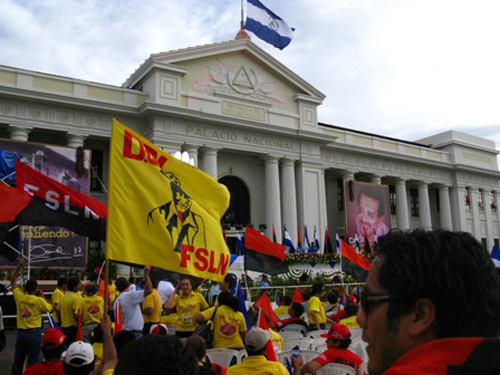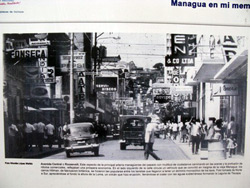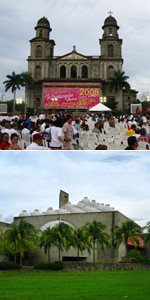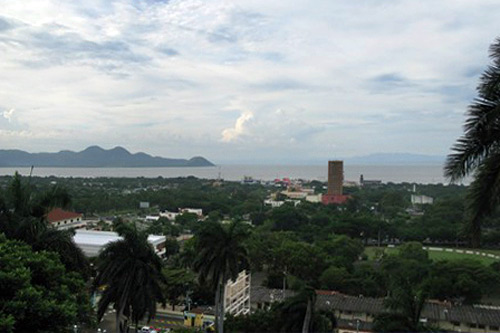
by Nathaniel Popkin
Philly Skyline Central American Correspondent
August 26, 2008
In the airplane on the way to Managua, my wife Rona and I were chatting with a Nicaraguan-American bringing his family home for an annual visit. He was a particular kind of
exiled Latino, whose middle class family fled during revolution -- preppy, with a well-coifed wife, and spoiled children. I was reading Salman Rushdie's 1987 literary embrace
of the Sandinista revolution, The Jaguar Smile, while he was touting his country's new casinos, malls, and foreign investment. "You'll see," he said, "[despite Daniel
Ortega and the Sandinistas] the country's really progressing."
But which direction is it?
On Friday, we found ourselves in front of the National Palace, in the middle of the celebration of the 30th anniversary of the August 22, 1978 ceding of power by the dictator
Somoza. Red and black Frente flags were everywhere and union members chanting "the people united will never be defeated." Daniel Ortega, on the usual pink
reconciliation banner, hand raised. The following day, Saturday the 23rd, was to be National Student Day and the celebration of the relative success of the
Sandinista literacy campaign, a point of melancholic pride in this country of poets: huge progress had been made in campesino literacy, but success has fallen back so
that at present the rate of illiteracy is still among the highest in the world.
The National Palace had been the site, six years before the revolution, of the December 23, 1972 earthquake, which cost 10,000 their lives and destroyed the entire old city
center. (Roberto Clemente was flying in aid on December 31 when his plane crashed.) Much international aid was pocketed by Somoza, only one of many stunning and brutal acts
that fueled the revolution.
 Just outside the National Palace is a small photography exhibition, "Managua in my memory." Here is the San Francisco-like capital, the most modern in Central America. Here
are busy commercial streets and here are highrises; here is urban form buffered by volcanic hills and swept by the wide expanse of Lake Managua. Now, in its place: the sense
of nothing, of emptiness (the National Palace is surrounded by empty lots and building skeletons.) One-story neighborhoods are busy, as any small city or pueblo in Nicaragua,
and the city's markets are legendary, but otherwise the city hasn't form.
Just outside the National Palace is a small photography exhibition, "Managua in my memory." Here is the San Francisco-like capital, the most modern in Central America. Here
are busy commercial streets and here are highrises; here is urban form buffered by volcanic hills and swept by the wide expanse of Lake Managua. Now, in its place: the sense
of nothing, of emptiness (the National Palace is surrounded by empty lots and building skeletons.) One-story neighborhoods are busy, as any small city or pueblo in Nicaragua,
and the city's markets are legendary, but otherwise the city hasn't form.
Below the hill inside of which Somoza kept his worst jails stands the un-city of trees, monumental traffic circles, and deep, defensive set-backs. ("This looks like
Managua," observed my daughter as we drove through South Jersey on the way home from the Atlantic City airport.)
 Though set back a football field from the street, Managua's
new cathedral is worth mentioning. (It's at bottom left.) The earthquake ruins of the old one stand next to the National Palace; it is top left, behind the
pink and orange banners.
But the new Cathedral of Immaculate Conception, funded by the right wing former owner of Domino's Pizza, Thomas Monahan, and designed by the Mexican architect Ricardo
Legoretta, is a hair-raising homage to Louis Kahn and a stunning piece of religious architecture. Incidentally it's the pulpit of the Nicaraguan cardinal Miguel Obispo y
Bravo, whose own political progression, from Somozaite to Sandinista, has bewildered Nicaraguans of every political stripe. Though set back a football field from the street, Managua's
new cathedral is worth mentioning. (It's at bottom left.) The earthquake ruins of the old one stand next to the National Palace; it is top left, behind the
pink and orange banners.
But the new Cathedral of Immaculate Conception, funded by the right wing former owner of Domino's Pizza, Thomas Monahan, and designed by the Mexican architect Ricardo
Legoretta, is a hair-raising homage to Louis Kahn and a stunning piece of religious architecture. Incidentally it's the pulpit of the Nicaraguan cardinal Miguel Obispo y
Bravo, whose own political progression, from Somozaite to Sandinista, has bewildered Nicaraguans of every political stripe.
I wrote earlier that one of the reasons for traveling to a place like Nicaragua (beyond Managua) is to experience a kind of pre-Modern sensation, to immerse oneself in a much
less mediated and sanitized world.
As we imagine it, progress has tidied things up a little too much. And so I emerge from this thoroughly captivating, enervating nation,
wondering how we in Philadelphia might find ways to push back through time; how we might learn to use our streets not just for cars but for people (and their bicycles); how we
might embrace quotidian street noise and music; how we might emerge en masse from our row houses and offices, not only when the weather is this good, but at all times of the
year.
City life, which so often enforces rigidity, ought also to let things go.

–Nathaniel Popkin
nathaniel.popkin@gmail.com
|